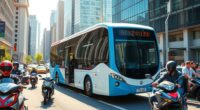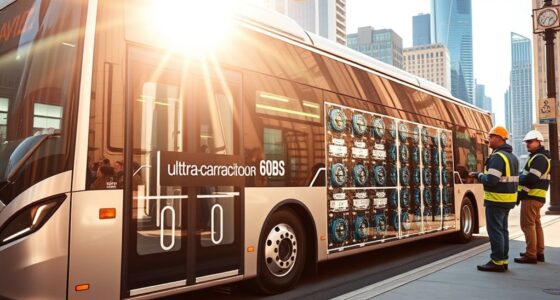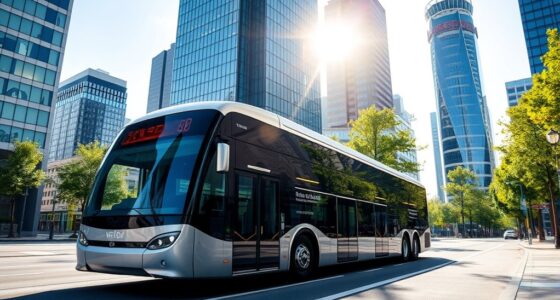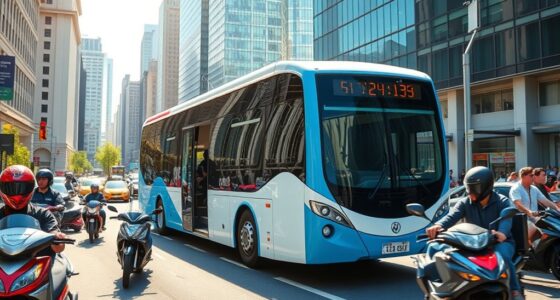By 2050, electric buses are expected to dominate, largely replacing traditional diesel and gas models worldwide. With technological advances, strong policy support, and decreasing costs, many cities are already shifting toward fully electric fleets. While some challenges remain, such as infrastructure development and initial expenses, the trend toward zero-emission transit is unstoppable. If you want to understand how this shift is accelerating and what it means for the future of transportation, keep exploring the details behind these changes.
Key Takeaways
- By 2050, electric buses are projected to comprise over 86% of the global fleet, significantly reducing reliance on traditional diesel buses.
- Technological advancements and decreasing costs favor widespread adoption, but complete replacement depends on infrastructure development and policy support.
- Environmental and societal benefits drive aggressive electrification efforts, yet some regions may face barriers due to high costs and logistical challenges.
- Transition timelines vary globally, with developed countries leading in electric bus adoption, while developing regions may lag due to resource constraints.
- Full replacement by 2050 is plausible but uncertain, influenced by economic, technological, policy, and societal factors shaping transportation strategies.
Global Adoption Trends and Forecasts for Electric Buses
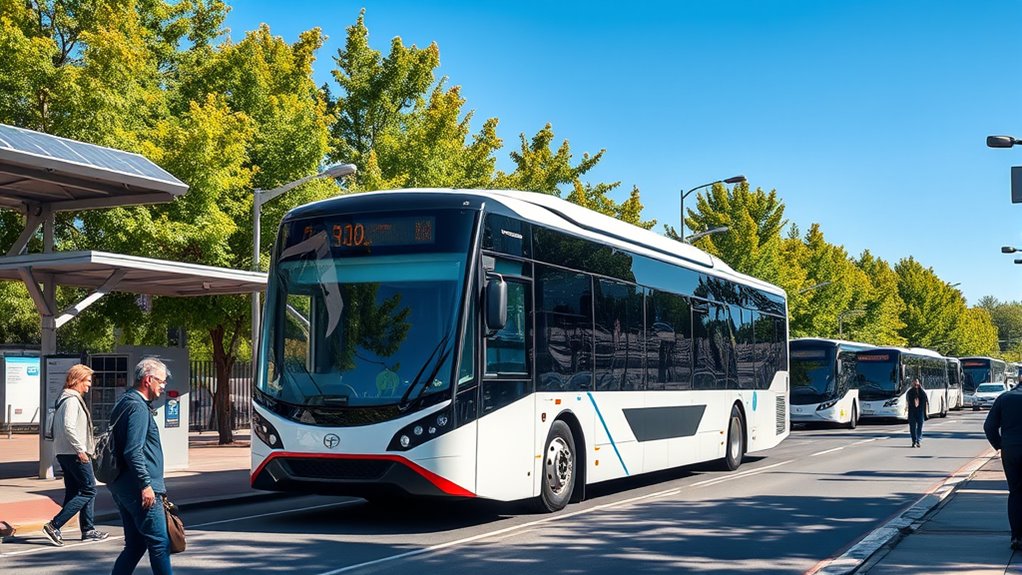
The adoption of electric buses is accelerating worldwide, driven by technological advancements, policy support, and growing environmental concerns. You’ll see sales surge, with forecasts exceeding 180,000 units by 2045, highlighting a significant shift in public transportation.
Electric bus adoption is rapidly increasing worldwide, driven by innovation, policies, and environmental priorities.
In 2025, about 11 to 13% of new bus sales in India are expected to be electric, with India projected to account for over 10% of global demand—more than Europe and North America combined.
The past decade has seen a dramatic move toward electric buses due to their efficiency and zero emissions, which help reduce carbon footprints. As these vehicles become more prevalent, the development of battery technology plays a crucial role in their wider adoption. Advancements in energy storage are expected to further enhance vehicle range and reduce charging times. Moreover, ongoing research into battery recycling methods will be essential to ensure sustainable lifecycle management of electric bus batteries.
Innovative financing models and government incentives, like India’s FAME program and US funding for electric school buses, further support widespread adoption.
Globally, cities are increasingly adopting electric buses to meet climate goals and improve air quality.
Additionally, advancements in battery technology and charging infrastructure are critical factors that will facilitate the mass adoption and operational efficiency of electric buses in the coming decades.
Market Dynamics and Competitive Landscape
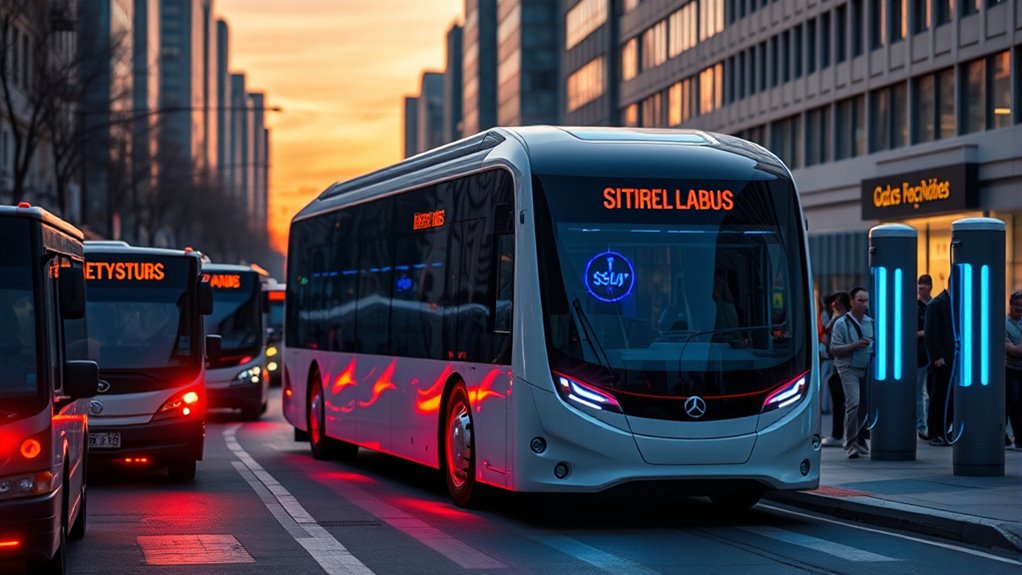
As electric buses gain momentum worldwide, understanding the market’s growth and competitive landscape becomes essential. The global electric bus market is projected to reach USD 187.8 billion by 2032, up from USD 64.2 billion in 2024, driven by government support, technological progress, and environmental benefits.
The Asia Pacific region is expected to dominate due to high production capacity and strong government backing, while North America will see the highest CAGR.
Key players like BYD and Yutong operate globally, with market dynamics influenced by affordable components and technological innovations. Improved battery tech and charging infrastructure boost adoption.
Competition remains fierce, with established brands and emerging companies offering innovative solutions to meet rising demand and overcome industry challenges.
Policy Initiatives and Funding Support

Policy initiatives and funding support play a vital role in accelerating the shift to electric buses worldwide. Global commitments aim for about 30% of transportation demand to transition to zero-emission vehicles by 2050, with policies like California’s AB 579 mandating all new school buses be zero-emission by 2035.
Massachusetts proposes a similar goal for 2040, focusing on underserved communities. Funding plays a crucial part too; California allocates significant funds for replacing diesel buses, while investments in charging infrastructure are supported by government and private sectors. Proper planning ensures that infrastructure development keeps pace with vehicle adoption, making the transition smoother. Additionally, collaborative efforts among public and private stakeholders enhance the effectiveness of these initiatives.
Incentives such as tax credits encourage adoption, and international aid helps developing regions transition. These policies and funding strategies create a supportive environment, speeding up the adoption of electric buses and paving the way toward cleaner transportation.
Additionally, advancements in battery technology continue to improve the range and affordability of electric buses, making widespread adoption more feasible.
Environmental Benefits of Transitioning to Electric Buses
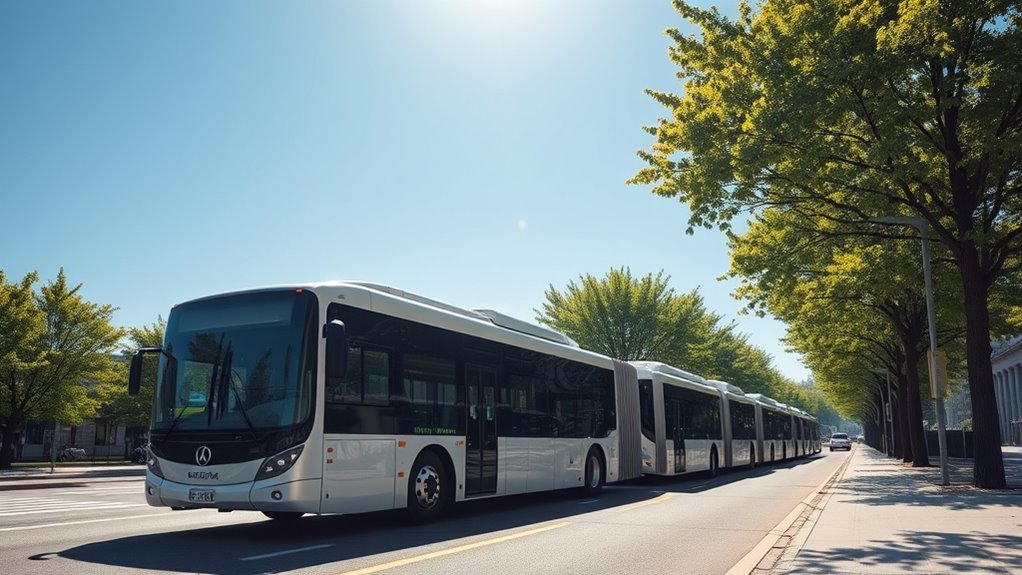
Shifting to electric buses offers considerable environmental advantages that can greatly improve urban living. They eliminate harmful emissions that contribute to ground-level ozone and climate change, markedly reducing greenhouse gases.
By removing diesel exhaust, electric buses enhance air quality, benefiting passengers and communities. This also lowers exposure to particulate matter, improving public health and reducing respiratory issues.
Additionally, electric buses operate quietly, decreasing noise pollution in cities. They support sustainable urban mobility by reducing pollution hotspots and promoting healthier environments.
Electric buses are more energy-efficient, converting more energy into movement and using regenerative braking to recover energy. With zero tailpipe emissions, their environmental impact depends on the electricity source, with renewables offering the greatest benefits. Proper maintenance can further maximize their efficiency and lifespan.
Furthermore, the integration of advanced automation in electric buses can optimize route planning and energy use, leading to even greater environmental benefits.
Challenges in Infrastructure and Operations

Implementing electric buses faces significant infrastructure and operational hurdles that can slow adoption. You’ll encounter higher upfront costs since electric buses are roughly 50% more expensive than traditional ones.
Developing charging infrastructure demands substantial investment, with costs between $20,000 and $25,000 per bus, including real estate and stations. Charging stations often outlast route contracts, complicating long-term planning, especially when space and power capacity are limited.
Managing electricity supply is complex, and utility rates can fluctuate, impacting operational costs. Building enough charging stations is challenging, especially at depots with space constraints. Grocery savings strategies can help offset some of these costs for transit agencies and taxpayers.
You’ll also need to train staff to operate and maintain electric buses properly, while coordinating charging schedules to ensure uninterrupted service. Proper installation and maintenance are essential for safety and efficiency, requiring careful planning and significant investment to overcome.
Additionally, integrating renewable energy sources into the power grid can enhance sustainability and reduce operational costs over time.
Regional Success Stories and Case Studies
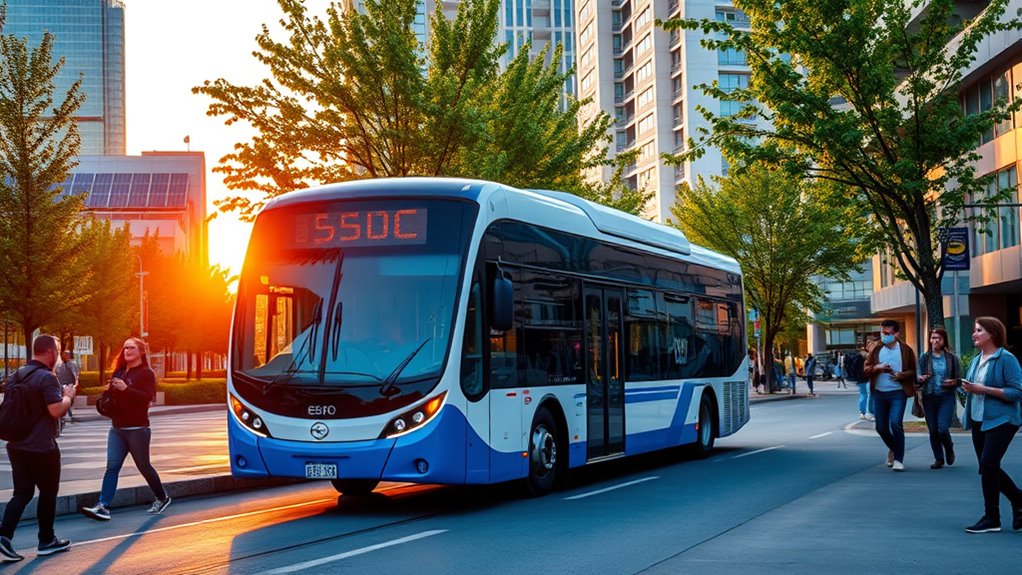
Despite the infrastructure and operational challenges faced by electric buses, several regions have achieved notable successes that highlight practical solutions and benefits. In California, the Antelope Valley Transit Authority became the first fully electric U.S. transit agency, phasing out diesel buses by 2020 and deploying 87 all-electric vehicles with wireless charging. These innovations demonstrate how electric bus deployment can effectively transform public transportation systems. Moreover, ongoing advancements in AI automation contribute to optimizing operational efficiency and maintenance, further encouraging adoption. Enhanced battery technologies and battery management systems are critical factors in increasing vehicle range and reliability, making electric buses more viable for widespread use. As technology continues to evolve, the integration of sustainable transportation strategies will be essential for long-term environmental benefits.
Central Contra Costa County replaced diesel trolleys with electric buses on key routes, focusing on cost-effective, end-of-life fleet conversions.
Shenzhen, China, leads globally with over 16,000 electric buses since 2017, mainly BYD K8 models, offering rapid scaling without route disruptions.
Smaller cities like Binghamton, New York, integrated EVs into municipal fleets, demonstrating scalable, cost-effective adoption.
Across the globe, reliability, battery performance, and operational costs have improved, accelerating shift efforts.
Technological Advancements and Future Innovations
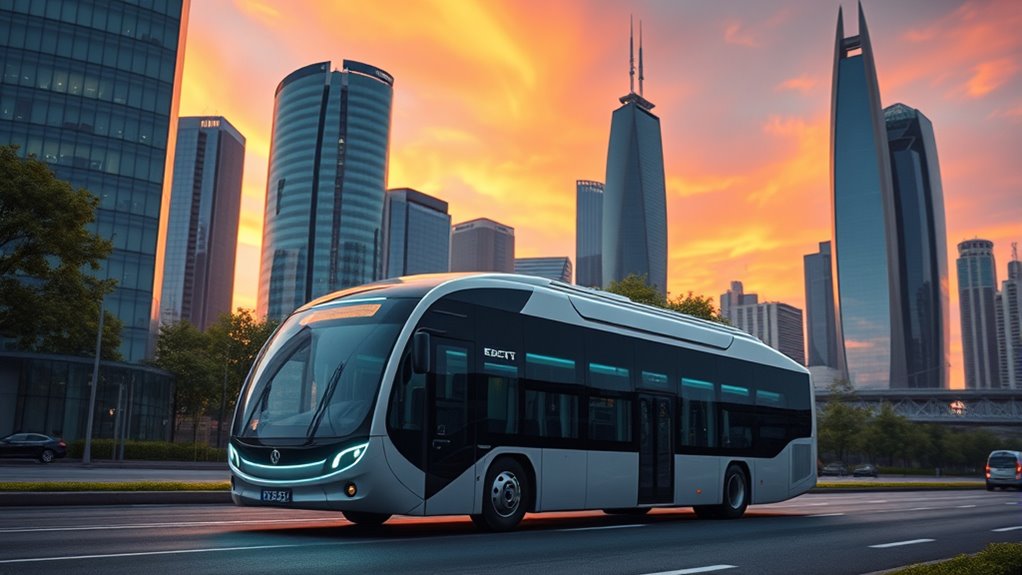
Technological advancements are driving the rapid evolution of electric bus systems, making them more efficient, affordable, and capable of meeting future transportation demands. You’ll see projected global e-bus sales surpass 60% by 2030, reaching 86% fleet share by 2050, with over 55,000 buses worldwide. Battery tech now offers 200–300 km ranges, with improvements aiming for 400+ km to match diesel counterparts. Fast-charging reduces downtime, and regenerative braking cuts operating costs. Dynamic modeling tools like PEER optimize routes and charging, addressing in-route charging challenges. Industry trends include policy support from the EU, subsidies, and standard protocols that improve compatibility. Predictive maintenance, smart grid integration, and data-driven route planning further enhance efficiency, ensuring electric buses are ready for widespread adoption by mid-century. Additionally, privacy and data management practices are vital for safeguarding user information as these systems increasingly rely on data collection and analysis to optimize performance and maintenance. Furthermore, advancements in battery recycling are crucial for sustainable growth and minimizing environmental impact over the long term. Incorporating advanced monitoring systems can further improve operational reliability and safety, supporting the seamless integration of electric buses into existing transit networks.
Factors Influencing the Pace of Adoption Toward 2050
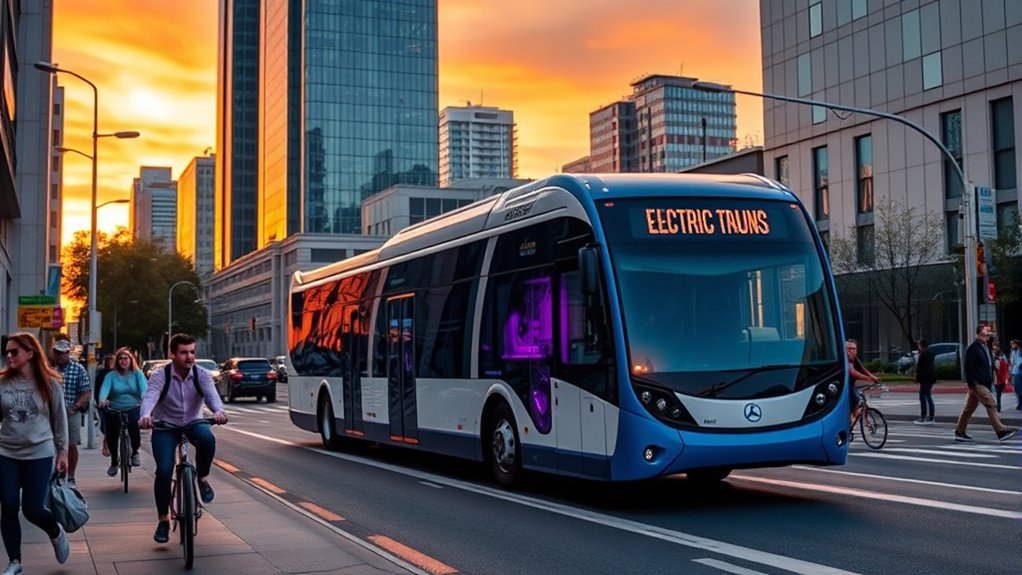
The rapid advancement of electric bus technology is only part of what determines how quickly these vehicles will replace traditional buses by 2050. Market and economic factors play a pivotal role; by 2050, e-buses could make up 86% of the global fleet, with India leading demand growth. In addition, the widespread adoption of sustainable practices like renewable energy integration further facilitates the transition to electric mobility. Incentives like India’s FAME program and decreasing costs make e-buses more competitive. Investment trends support mass adoption worldwide. Policy frameworks, including targets, mandates, incentives, and international cooperation, accelerate deployment. Environmental benefits, such as reducing air pollution and carbon emissions, motivate adoption, especially with clean energy integration. Infrastructure development, like charging stations and upgraded grids, is essential. Moreover, market readiness—including manufacturing capacity and supply chain resilience—significantly influences the speed of transition. Building a resilient supply chain is crucial to meet the increasing demand for electric buses and ensure timely deployment. Additionally, global technological innovation drives improvements in battery efficiency and vehicle performance, further supporting widespread adoption. Social factors, including public perception and education, influence acceptance, shaping the pace of transition toward 2050.
Frequently Asked Questions
What Are the Long-Term Economic Impacts of Transitioning to Electric Buses?
You’re considering the long-term economic impacts of switching to electric buses. You’ll see lower operating costs and potential savings from reduced fuel and maintenance expenses.
However, you should also account for high initial investments in infrastructure, battery replacements, and subsidies.
Over time, economies of scale and technological progress could lower costs.
How Will Electric Buses Affect Urban Traffic Congestion Patterns?
You might think electric buses will just add to urban chaos, but in reality, they’ll help ease traffic congestion. Thanks to smarter routing, quick acceleration, and quieter operation, you’ll notice less traffic and noise.
As cities adopt these eco-friendly vehicles, your commute could become smoother and more efficient. So, instead of worsening congestion, electric buses are poised to transform urban traffic into a more manageable, cleaner, and quieter experience for you.
What Training Is Required for Maintenance Staff of Electric Bus Fleets?
You need specialized training for maintaining electric bus fleets. This includes high voltage safety protocols, PPE use, and lockout-tagout procedures.
You should also learn battery diagnostics, thermal management, and electric propulsion system servicing.
Troubleshooting charging infrastructure and using diagnostic software are essential.
Plus, ongoing refresher courses, competency assessments, and cross-training guarantee your skills stay current, helping you safely and effectively maintain these advanced, eco-friendly transportation systems.
How Do Electric Buses Perform in Extreme Weather Conditions Worldwide?
So, you’re curious how electric buses handle Mother Nature’s tantrums worldwide? Well, they’re surprisingly resilient—cold weather can cut their range by a third, but proper management keeps them rolling through winter’s worst.
Hot climates demand route planning to avoid overheating, and AC use impacts efficiency. With the right tech and strategies, these buses perform admirably, proving they’re not just fair-weather friends but tough enough for any climate.
What Are the Privacy and Data Security Concerns With Smart Charging Systems?
You should be aware that smart charging systems pose significant privacy and security risks. These include the potential exposure of sensitive data through high-resolution energy tracking and third-party sharing, vulnerabilities in outdated firmware, unencrypted communications, and phishing threats. Without proper safeguards like encryption, zero-trust architecture, and regular testing, your fleet could face cyberattacks, data breaches, or misuse of operational information, putting your operations and passengers at risk.
Conclusion
Think of the shift to electric buses as sailing toward a cleaner horizon. While some storms—like infrastructure hurdles—remain, the lighthouse of technological innovation and policy support guides your journey. By 2050, you might find yourself on a fleet of silent, eco-friendly buses that transform urban landscapes. Embrace the voyage, for every step forward lights the way to a sustainable future, turning the horizon into a reality worth reaching.

